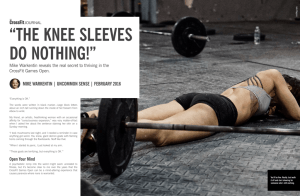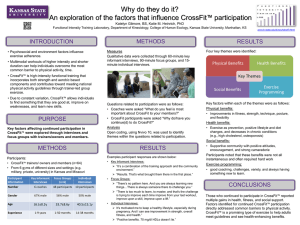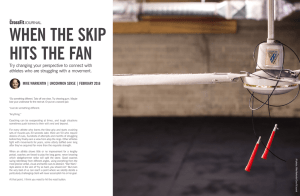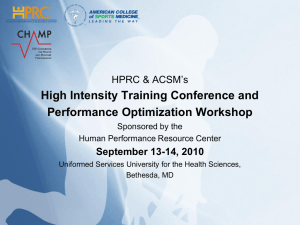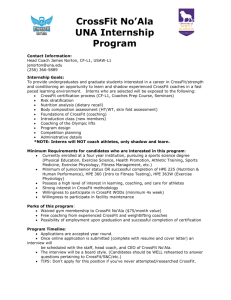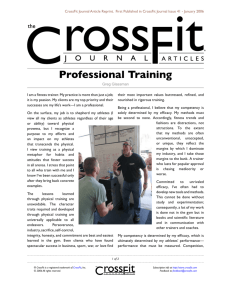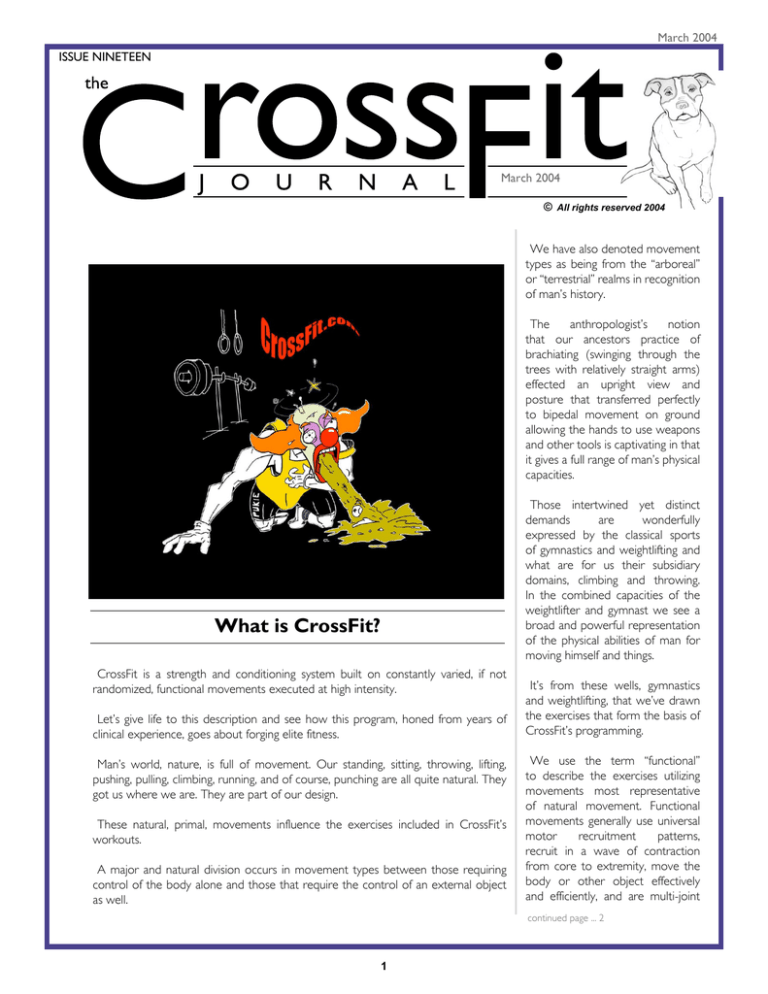
March 2004
ISSUE NINETEEN
March 2004
© All rights reserved 2004
We have also denoted movement
types as being from the “arboreal”
or “terrestrial” realms in recognition
of man’s history.
The
anthropologist’s
notion
that our ancestors practice of
brachiating (swinging through the
trees with relatively straight arms)
effected an upright view and
posture that transferred perfectly
to bipedal movement on ground
allowing the hands to use weapons
and other tools is captivating in that
it gives a full range of man’s physical
capacities.
Those intertwined yet distinct
demands
are
wonderfully
expressed by the classical sports
of gymnastics and weightlifting and
what are for us their subsidiary
domains, climbing and throwing.
In the combined capacities of the
weightlifter and gymnast we see a
broad and powerful representation
of the physical abilities of man for
moving himself and things.
What is CrossFit?
CrossFit is a strength and conditioning system built on constantly varied, if not
randomized, functional movements executed at high intensity.
Let’s give life to this description and see how this program, honed from years of
clinical experience, goes about forging elite fitness.
Man’s world, nature, is full of movement. Our standing, sitting, throwing, lifting,
pushing, pulling, climbing, running, and of course, punching are all quite natural. They
got us where we are. They are part of our design.
These natural, primal, movements influence the exercises included in CrossFit’s
workouts.
A major and natural division occurs in movement types between those requiring
control of the body alone and those that require the control of an external object
as well.
It’s from these wells, gymnastics
and weightlifting, that we’ve drawn
the exercises that form the basis of
CrossFit’s programming.
We use the term “functional”
to describe the exercises utilizing
movements most representative
of natural movement. Functional
movements generally use universal
motor
recruitment
patterns,
recruit in a wave of contraction
from core to extremity, move the
body or other object effectively
and efficiently, and are multi-joint
continued page ... 2
1
March 2004
What is CrossFit?
Editor
...continued from page 1
“compound” movements,
which are neurologically
irreducible.
The movements we’ve
selected are in large part
responsible for the potency
of the CrossFit protocol.
We say, “The magic is in
the movements”.
For us the process of
reviewing,
testing,
and
evaluating exercises for
selection is constant.
Criteria
for
selection
include, range of joint
motion, uniqueness of line
of action, length of line of
action, strength of line of
action, commonness of
motor pattern, demands
on flexibility, irreducibility,
utility,
foundational
value, neurological value,
measurable impact on
adherents, and, frankly,
potential for metabolically
induced discomfort.
Our
workhorse
movements
include
deadlifts, squats, pull-ups,
running and lunging, pushups and dips, presses and
jerks, cleans and snatches,
rope
climbing,
sit-ups,
jumping, throwing, pressing
to handstand and some
hybrid movements like the
muscle-up, clean & jerk,
“wall-ball”, and “thruster”.
This cast of characters well
represents the range of
useful natural movements
found in man; they are
the “alphabet” from which
Kelly Moore Champion Powerlifter
On CrossFit, superior fitness, and general physical preparedness
Superior fitness - you bet. I
couldn’t hold a candle to my
current overall fitness despite
long hours in the gym following
powerlifting and bodybuilding
routines. Better cardiovascular
condition, better endurance, a
little better flexibility and more
determination and focus...I’m in
the best condition of my life. Superior health - I don’t know if it’s
CrossFit, better eating or a combination of the two, but I haven’t
had a full blown cold or flu despite lots of stress, overtime and night
shifts with ill co-workers in an enclosed and shared keyboard/phone
environment. I also sleep better than I have in years.
Superior GPP - no question that CrossFit works. Throwing hay bales,
pushing a wheelbarrow loaded with wet manure through 4” of mud,
hauling shavings from the arena to the barn all feel like a warm-up
now rather than a workout. Even my cardio and overall quickness
has become better - occasionally some of the horses will refuse to
go into their pasture area and I will need to go out and get them
moving in the right direction. If the normal persuasion fails, I need to
herd them to where they need to go. This involves sprinting and fast
lateral direction changes. Depending on how cooperative the horses
feel, this activity may take several very CrossFit-like minutes. I used
to nearly collapse in a heap after a session, now it’s just another
thing to do.
I do have to tell you that CrossFit is the most productive fitness
program I’ve ever used in 20+ years of lifting. I’m stronger in almost
every lift, am participating in rudimentary gymnastics, running, and
performing lifts I never dreamed I could. Although I know it’s not
an important factor, I also have to share with you several things
friends have said regarding my changing body condition. People
who have known me for years have commented that my shoulders
are broader, my back wider, my arms are much bigger, forearms are
more muscular, and waist is tighter and that there is less fat on my
butt and thighs. How amusing, I’m achieving a bodybuilder’s dream
without bodybuilding! The effects of CrossFit on both my fitness
performance and my appearance have been dramatic.
Another interesting note: my father was very supportive of my lifting
and competing. He would attend meets and shows, take pictures,
and brag to his friends. But one thing he said bothered me. He asked
me how I could look like I did, lift as much as I did, but still struggle
to lift those 50# bags of cement mix to my shoulders and take them
300 feet to the shed? I guarantee I wouldn’t have trouble handling
those bags now!
more complex and natural
movements are formed.
Our toolbox contains
gymnastics rings, barbells,
bumper plates, dumbbells,
parallel bars, pull-up bars,
medicine balls, rope, mats,
and some odds and ends
like kettlebells, a giant tire,
and sandbags.
Our tools and exercises
have long records of
distinction
outside
of
and long before CrossFit.
In earlier times every
“gymnasium” had parallel
bars, rings, vaulting horse,
dumbbells, barbells, and
heavy bags. The rudiments
of
gymnastics
and
weightlifting were taught to
all school kids. They were
also an integral part of
military physical training.
Today, outside of the
CrossFit
community,
gymnastics and weightlifting
protocols rarely mix. The
most effective stimulus for
developing agility, balance,
coordination,
accuracy,
flexibility, trunk control,
and upper body strength
rarely mixes with the
most effective stimulus
for developing overall
strength, power, speed, and
explosive hip extension.
CrossFit’s vast clinical
experience with functional
movements
strongly
suggests
that
these
movements are not only
safe but also absolutely
essential to health and
continued page ... 3
2
March 2004
What is CrossFit?
Editor
...continued from page 2
fitness. Provocatively, it is our contention
that non-functional movements not only
render a seriously blunted training response,
but that they are collectively, in contrast to
functional movements, unsafe.
so much about what goes on inside, we’re
keeping our eye on inputs and outputs,
workouts and results alone. This approach
has kept us a generation or two ahead of
theory-based programming. Experts offering
fitness, nutrition, or health regimens that
they claim are distilled from first principles
rather than clinical practice are fooling
those who listen to them and, as often as
not, themselves as well.
Our protocol has been tested across the
broadest spans of human capacity with
but minor modifications to exercises and
workouts. Our claim of a universally scalable The concept of neuroendocrine response
program has been proven sound.
provides a theory as to how and why not
only an exercise, but an entire regimen
Beyond safe and essential, we’ve found might contain distinct and powerful
that functional movements form the basis biochemical advantages. It is our suspicion
for dramatically effective rehabilitation from that CrossFit’s entire repertoire of
injury and illness. Be sure that we are talking movements and even workouts themselves,
about squats, deadlifts, pull-ups, and push- elicit a powerful neuroendocrine response.
ups and not rolling around on Swiss balls We’re waiting for some professor to prove
and playing with Theraband. Functional it.
movements scaled to capacity, that is,
coupled with common sense and patience Until then, let’s examine how we mix the
offer the quickest path to full habilitation. functional movements to distinct advantage
We believe that this is the future of physical and then explore those advantages.
therapy.
On the potency of functional exercises we
In terms of performance, the functional say, “The magic is in the movements”, but
exercises are singularly unique in developing our line on maximally effective programming
strength, speed, and power. Several of our is, “The art is in the mixing.”
functional exercises, the deadlift, clean, and
squat to name three, have been shown The fitness that CrossFit advocates and
to alter hormone and neurotransmitter develops is broad, general, and inclusive.
production.
This
“neuroendocrine” Our specialty is not specializing. Combat,
response is widely held to explain curious survival, many sports, and life reward this
phenomenon like the squat’s development kind of fitness and, on average, punish the
of upper body strength. The neuroendocrine specialist.
response offers a more systemic and less
mechanical view of strength development.
In practice, this encourages the athlete to
disinvest in any fixed notions of sets, rest
Neuroendocrine response has nothing periods, reps, exercises, order of exercises,
to do with our selection of exercises, routines, peridodization, etc. Nature
however. We’ve chosen the exercises we frequently provides largely unforeseeable
have because of their observed leverage in challenges; we train for that by striving
conferring strength and capacity past their to keep the training stimulus broad and
more apparent or obvious, mechanical or constantly varied.
anatomical, advantages. Neuroendocrine
response may explain our program’s efficacy, We want to develop the capacity for
however.
elite performance in any combination of
functional movement across a broad range
We’re making the important point here of challenges or demands. (See “What is
that our protocol has been developed Fitness?” CFJ Issue 2.)
experientially or empirically. We call it the
black-box model. We don’t know or care
3
Introducing the idea of the “functional
couplet” and using a simple design template
shows how simple and yet how much artistry
can go into making CrossFit workouts.
A “functional couplet” is a pairing of two
functional exercises. Period. The most
intriguing, and perhaps effective, are those
comprised of a classic weightlifting or weight
training movement coupled with a classic
gymnastic or calisthenic movement. The
best couplets are whole body monsters
like thrusters and pull-ups or deadlifts and
handstand push-ups.
Functional couplets make perfect CrossFit
workouts when used as timed circuits where
the athlete either attempts a predetermined
number of rounds for best time (task
priority) or works to complete as many
rounds as possible in a predetermined time
period (time priority).
Generally, the task priority couplets will go
3-5 rounds and the time priority couplets
no more than 20 minutes but anything is
possible and fair game. These workouts will
last between 3-20 minutes and probably
average 15. One hour including warm-up
and cool down and stretching is plenty.
The workouts can be worked at such
blistering intensity, and should be, so that
on the following day some rest, or at least a
change of tempo is needed. For our simple
template we will call these days “focus
days”.
A focus day would be ideally spent in
one of three manners. The first would be
a distance effort, i.e., bike, run, swim, or
row long. The second would be to focus
on developing a gymnastics skill, e.g., press
to handstand, pirouette, back flip. The third
manner would be to focus on single rep
efforts of a basic lift or, perhaps, concentrate
on technique as with the O’lifts. This is a
great day to work on fixing chinks in your
fitness armor.
Following the focus day is another couplet
and the fourth day is a rest day. So, a single
continued page ... 5
March 2004
What is CrossFit?
Editor
Robb Wolf
CrossFit Coach, Founder of CrossFit Norcal
Regimens built from functional exercises at high intensity and constantly varied structure Produce a superior cardiorespiratory adaptation
Are essential to fitness and health
Health and Fitness, although difficult to define precisely, share many interconnected attributes. Among these are:
appropriate immune response, insulin sensitivity, the acquisition and maintenance of lean muscle mass, the ability to
cope with acute stressors, the maintenance of physical, emotional and intellectual elacticity and the ten general physical
skills as defined by the 10/2002 CrossFit Journal.
CrossFit, through the application of functional movement performed at high metabolic output, achieves an
unparallel degree of health and fitness. This may appear a bold claim until one considers how the best minds in paleoanthropology, sports science and human genetics are approaching the topic:
http://www.thepaleodiet.com/articles/Int%20J%20Sport%20Article.pdf
http://jp.physoc.org/cgi/content/full/543/2/399
Constitute the most effective rehabilitation from injury –
Rehabilitation may be viewed as a continuum spanning the states of prehabilitation to recovery. Prehabilitation includes biomechanically
sound motor recruitment patterns created in the execution of functional movements. Non-functional movements, by their nature, are
pathogenic in that they create muscle imbalance and faulty motor recruitment and they compromise joint integrity. Prehabilitation is also
characterized by the turnover of bio-molecules in muscle, tendon, bone ligament, cartilage etc. This turnover facilitates growth and repair
and is optimized, not coincidentally, when the parameters of health and fitness (hormonal state, immune function) are also optimized.
Recovery from a pathological condition which may include tissue damage, loss of proper neuro-muscular function, compromised
immunity and stress response is qualitatively no different from prehabilitation. If functional movements are utilized the greatest
recovery potential may be realized. Non-functional movements create smaller recovery potentials and will promote further pathology.
Comprise the only truly safe protocols-by their very nature
Functional movements support and protect joint and tissue integrity at any loading paramater via biomechanical efficiency AND sound
motor-recruitment patterns.
Non-functional movements do not provide this benefit and are consequently unsafe.
Elicit an inordinate neuroendocrine response The neuroendocrine response, as the name implies, has both a neurological and a hormonal component. The hormonal component
is characterized by increased free circulating hGH, insulin like growth factor and testosterone as well as aspects of acute adrenal cortical
response. Metabolically this translates into enhanced tissue repair and improved nitrogen retention. The neurological component
appears to improve efficiency at the neuro-muscular junction and likely improves rate coding and recruitment patterns. Only functional
multi-joint movements such as those found in gymnastics, throwing, Olympic lifting and sprinting elicit a neuroendocrine response of
appreciable magnitude.
Are singularly unique in developing core strength From a functional standpoint core strength and midline stability are perhaps better described than defined. True core strength involves
the transfer of significant forces through the trunk musculature. This may involve rotation as in punching, kicking and throwing or
maintaining a rigid torso in the Olympic lifts, linear flips, vaults and jumping. Individuals who develop the core strength to perform well
in these movements typically find any amount of Swiss ball crunches or other low quality movements to be superfluous. It is readily
apparent that no amount of low quality movement will translate into functionality.
Yield unparalleled general physical preparedness or fitness General physical preparedness (GPP), as described by Verkoshansky and Bompa, prevents injury, increase work threshold and is the
basis whereby sport specific training may be conducted at levels consistent with elite performance. Historically GPP has consisted of
sled drags, complexes, and body weight calisthenics performed at high intensity with resultant improvements in aerobic and anaerobic
endurance, enhanced recovery, above normal neuroendocrine response, and accentuated hypertrophy. The key features of GPP, and
CrossFit, are functionality, generality and intensity.
Crossfits’ reliance upon functional movements from gymnastics, Olympic lifting and sprinting mixed in a randomized fashion, with keen
attention placed on energy system demands, ensures the most general, prepared fitness possible.
It is important to note that GPP is tapered cautiously prior to competition in elite level throwers, Olympic lifters, gymnasts and others
due to an inability to withstand Sport Specific Training volumes WITHOUT GPP.
Bompa, T. (1999) Periodization: Theory and methodology of training. Kendall/Hunt
Verkoshansky, V. (1988) Programming and Organization of Sports training. Sportiviny Press, Livonia, MI
4
March 2004
What is CrossFit?
Editor
...continued from page 3
cycle of our template looks like this: Couplet,
Focus, Couplet, Off. This is a three days on
one day off regimen.
In these workouts the reps, sets,
length of workout, exercises, and
combinations of exercises vary greatly
while the intensity stays relatively high
and the movements are all functional.
We started with a description
of CrossFit as “a strength and
conditioning
system
built
on
Sixteen-day Cycle
constantly
varied,
if not randomized,
1. Five rounds for time of:
functional movements
Deadlift 185 pounds 15 reps/10 handstand push-ups
executed at high
intensity.” Our 162. Run 5K for time
day sample fits the
description.
3. How many rounds can you complete in 20 minutes of:
24” Box Jump X 25 reps/5 Muscle-ups?
Athletes with a
primary sport would
4. Off
want to squeeze
CrossFit
workouts
5. How many rounds can you complete in 15 minutes of: Hang
around their major
squat clean 135 pounds 12 reps/15 Ring dips?
sport practice and
training, but they
6. 5 sets of 50 Sit-ups on GHD
would not need
additional strength
7. Five rounds for time of:
and
conditioning
35 pound Dumbbell thrusters X 15 reps (front squat/pushwork. This can be a
press)/12 pull-ups
delicate
operation
in that the workouts
8. Off
are so demanding
that the specter of
9. Five rounds for time of:
overtraining
may
60 pound two hand dumbbell swing X 21 reps/Glute-ham
arise. These workouts
developer medicine ball throw sit-up with 12 pound ball X 15
are very potent
medicine and need
10. One set of max rep pull-ups every 12 minutes or six sets.
to be introduced
gently especially if
11 .How many rounds can you complete in 20 minutes of:
supplementing
a
Run 400 meters/Deadlift 225 pounds X 7 reps?
rigorous
athletic
training schedule.
12. Off
Athletes preparing
13. Seven rounds for time of:
for special forces
Front squat bodyweight 10 reps/30 feet of rope climb
selection, pararescue
indoc, BUDS, or
14. Snatch nine sets 3-3-2-2-2-1-1-1-1
other
military
PT will find that
15. How many rounds can you complete in 20 minutes of:
supplementing the
Bench press 135 pounds 10 reps/12 “L” Pull-ups?
CrossFit
workouts
with some extended
16. Off
5
distance running or swimming work and
additional calisthenic training consistent with
the program’s expectations will give a great
foundation. This additional work would be
treated exactly like sport. Also, the focus
days are perfect for testing selection goals
and standards.
Invariably, if not always the question comes
up regarding “cardio”. “What about the
cardio?” is the standard refrain.
The answer is simple yet hard to believe
for many: The “cardio” is built into the
workouts themselves. Cardiorespiratory
adaptations don’t develop independently of
exercise and movement.
Much of cardiorespiratory adaptations
are specific to the training modality. VO2
max, the gold standard for aerobic fitness,
is fairly specific to the mode in which it is
developed. What we’ve discovered is that
the specificity is lessened and the aerobic
benefit of an activity transferable largely to
the degree that the activity in which it was
developed is functional and representative
of the intended application.
This leads us to offer that running is a
better aerobic preparation than bicycling for
close quarter combat but thrusters and pullups would be better yet.
In total, the strength of our training
stimulus gives an adaptation so broad and
deep that we have not only matched the
cardiorespiratory development of other
protocols but surpassed them readily,
leading to our claim that CrossFit is an
unrivaled protocol for developing general
physical preparedness and that our system is
an ideal kernel from which to develop more
specialized but no more fit capacities.
In “What is Fitness?” (CFJ Issue 2) we
explained what we thought fitness should be
and what it is for us. Since that issue, nearly
sixteen months ago CrossFit has been tested
repeatedly by many of the world’s toughest
men in the world’s toughest environments
and proven uniquely effective. Some day,
someone is going to do a study.
March 2004
What is CrossFit?
Editor
Mark Twight
Alpinist, President Mountain Mobility Group, Trainer to SOCOM personnel and
FBI Hostage Rescue Team, author of “Kiss or Kill – Confessions of a Serial Climber”,
and “Extreme Alpinism: Climbing Light, Fast and High”, Founder of Gym Jones – a
CrossFit affiliate in Salt Lake City.
The following was excerpted from several of Mark’s posts on the www.crossfit.com message board.
“You can talk all you want about being in good shape until you do a few CrossFit workouts. And then you
will realize -- like I did -- that what you have been doing is likely training strong points, rarely working on weak points, and training efficiency
to such a degree that the workouts you do are less effective than they might be if you mixed energy modes, duration, and types of work.
You probably know something about climbing-specific training because of books like Ex Alp, Clyde’s book, Dale’s book, and maybe
Will’s. But none of this will prepare you for what is to come if you make even the slightest effort to follow CrossFit. Coach invited me to
CrossFit HQ for an instructor seminar. I was the weakest guy in attendance, by at least 50% during every workout we did over the three
days. Those days changed my life. I could “what if?” my old training program and all the years I missed when I thought I was fit but I was
nowhere near my potential but the key is to move on when you know that something better is out there, without second-guessing. I
don’t believe I will find anything better than CrossFit for developing power, endurance, lactate tolerance, stamina (local area endurance),
balanced muscle groups, efficient neurological pathways (in the context of movement), etc. The bottom line: I started toying with the
CF protocol last April without truly understanding it. I improved in some diverse areas of fitness but had not seen the light or my own
potential yet. I went to CFHQ 1 December. Since then I have lost 12lbs, leaned out, and I am approximately 25% stronger across the
board without significant negative effect on endurance despite the short duration of our workouts (nothing longer than 25 minutes, with
the norm being half that or less).
I had purposefully not skied or climbed much all winter (prior to this I only climbed 4 days, all teaching, and went ski mountaineering
once). I only did CF type workouts from November 1. I have an aerobic base and movement efficiency developed over many years
but still, I never ran more than 400m with exception of one 3k per a particular WOD, never rowed more then 30 minutes (and
this at very low HR). Results were encouraging; during the ski mountaineering days I had plenty of gas for power-endurance
efforts, went 4-6 hours each day, never felt aerobically pressured, stayed mentally sharp and recovered quickly. Ice climbing
days were on relatively easy routes and the only challenge I felt was (as usual) grip endurance, which is VERY specific and despite
training on rings, the fat pull-up bar, isometric farmer bar holds, etc. this must be “re-educated” through actual practice of the sport.
But grip endurance was not an anticipated part of the test. All I was interested in was whether the anaerobic and lactate tolerance
training common to CrossFit would have positive influence on pure aerobic effort of significant duration (i.e. 20 to 40 times
longer than an average CF workout, which is still lower than the final the target duration) and the answer is a resounding, “yes.”
I still need to do some benchmark ski mountaineering days to make “exact” comparisons with previous (one to two years ago) effort.
I put “exact” in quotation marks because not only do snow conditions change but my body has changed a lot from doing CrossFit and
eating Zone/Paleo as well: I am 13lbs lighter than the previous two winters, which will have positive effect on VO2 Max and O2 uptake
efficiency, I can push (dips and push-ups) harder now, which would have a positive effect on poling on uphill or flat terrain, I have stronger
hips, which allows me to stand upright and push with glutes, etc. when skiing uphill instead of leaning forward and relying mostly on my
quads. The upright position improves breathing efficiency as well. I have a much stronger core, and this increases the efficiency of all
movement. So, while the tests cannot produce an exact comparison they do show, and I expect future tests to give similar results, that CF
has positive benefits for endurance and power-endurance effort. Good results with fewer destructive side effects than those associated
with long, slow distance, oxidative type training.
I’m certainly not finished with this “test” but I am really psyched with the results so far. Being a skeptic at heart I keep
asking, “how is this possible?” I am trying to overcome more than 20 years of training programming. My body is doing it
just fine but my brain is still shouting that something is not right! It is an amazing process to be going through at age 42.
Previously, training for big routes in Alaska, the Himalayas or the Alps I did spend time lifting but I focused mainly on movements I thought
continued page ... 7
6
March 2004
What is CrossFit?
Editor
...continued from page 6
related to climbing: the five core exercises
were pull-downs (seated with knees locked
under a plate for the higher weights),
finger curls (standing, with an Olympic
bar), one arm rows (bent over, one knee
on bench), leg press (on a machine), calf
raises (standing, also on a machine). I was
pushing and pulling some remarkable weight
for my bodyweight. I combined the weight
room with metabolic work on a road
bike, some skate skiing, and either running
or skiing uphill. Then stacked with long
days in the mountains onto the program.
Strangely, I never believed strongly in the
need for massive hours of aerobic base.
The scientists say I was wrong but I never
felt like a lack of fitness caused me to fail
on any routes. There were guys I could not
keep up with, of course, but that may result
from many causes. In the early years my
longest “artificial” metabolic workouts lasted
a couple of hours, max. That changed in the
mid-1980s when I realized how slow most
guys were going in the mountains and that
maybe their slow training modality was the
cause. They trained at a moderate level of
effort for long, long hours so they never got
to know what intense and fast really meant,
never could express it in the mountains.
So I started training shorter duration of
higher efforts but never got below 45-60
minutes during the metabolic workouts. It
certainly improved lactic acid tolerance and
pushed my anaerobic threshold higher but
not to the same degree as CrossFit has.
And I eventually adapted to the training
because it was so repetitive, working the
same energy systems in the same way over
and over. I never got bored to the point of
detraining myself but I realize how efficient
I became at certain types of effort, which
ultimately reduced the value of the training.
Now, with several months of CrossFit under
my skin, and many conversations with Coach
I recognize that, while fitness might never
have caused me to fail, I could certainly have
achieved higher and broader levels of fitness
by following a protocol other than the one
I developed on my own or with equally
narrow-minded coaches who thought
there was one right way to get there.
The CrossFit Journal is an
electronically distributed magazine
(emailed e-zine) published monthly
by www.crossfit.com chronicling
a proven method of achieving elite
fitness.
I wish I had discovered the rings as a tool
15 years ago. I wish I had discovered
the need for effective core and midline
stabilization, and learned how a weak SI
joint was costing me energy. I wish I had
dipped below the 45-60 minute metabolic
duration into the 20-minute area at much
higher intensity -- but years of programming
insisted that this did not make sense.
For subscription information go to
the CrossFit Store at:
http://www.crossfit.com/cf-info/
store.html
I am pleased that, while I might have done
more, better if my training program had
been different back then, I am able to
move ahead with something new. One of
my partners adamantly refuses to move on
because that would force him to consider
that he wasted the last ten years on a less
effective protocol ... he’s training massive
hours at a Zone 1 HR, finally starting one
interval day per week last week. I can’t wait
to get with him and test the results of our
different training programs!”
or send a check or money order
in the amount of $25 to:
CrossFit Manifesto:
Your input will be greatly
appreciated and every email will
be answered.
CrossFit
P.O. Box 2769
Aptos CA 95001
Please include your
name,
address
email address.
If you have any questions
or comments send them to
feedback@crossfit.com.
Regimens built from functional exercises at high intensity and constantly
varied structure •Produce a superior cardiorespiratory
adaptation
•Are essential to fitness and health
•Constitute the most effective rehabilitation from injury
•Comprise the only truly safe protocols
•Elicit an inordinate neuroendocrine
response
•Are singularly unique in developing
core strength
www.crossfit.com
•Yield unparalleled general physical
preparedness or fitness
© All rights reserved 2004
7
®
CrossFit is a registered trademark of CrossFit Inc.

